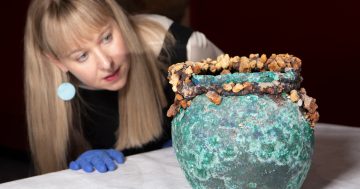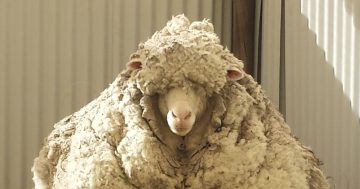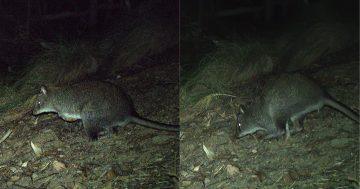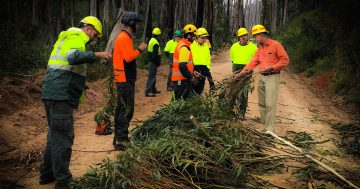
NMA Curator Karen Schamberger and Conservator Prue Castles during the installation of the thylacine pelt. Photo: Jason McCarthy, NMA.
Visitors to the National Museum of Australia can now view a newly acquired rare skin of the extinct Tasmanian tiger or thylacine.
The Museum acquired the thylacine pelt, one of the best preserved in known existence, late last year after it spent nearly 100 years hidden away in New Zealand. It went on public display on Thursday (14 February).
It says the almost-complete pelt features rarely preserved details such as a nose, tail and the bones, tissue and ligaments of the paws, and is in remarkable condition after spending most of its life in a drawer at its collector’s home.
National Museum Deputy Director, Stephanie Bull, said the Australian Government supported the purchase through the National Cultural Heritage Account.
“After an extensive evaluation process, the skin was purchased by the National Museum of Australia in late 2018 for $250,000 which included a generous contribution from the National Cultural
Heritage Account of $125,000,” said Ms Bull.
Head Curator Dr Martha Sear said the pelt had been added to the National Historical Collection to better represent Australia’s unique fauna and the environmental impact of species loss.
“The pelt is considered to be one of the best preserved specimens in existence, and one of the few remaining physical specimens of a species that has become a symbol of extinction,” Dr Sear said.
NMA Curator Karen Schamberger said the female thylacine was probably a young adult when she died and the flaps of skin near her hindquarters were thought to be the remnants of a pouch.
“The fur is soft and the colour is strong, not faded. The pelt is almost complete, with foot bones and associated tissue. These will likely provide potential for osteological and genomic analysis as well as providing potential information for aspects of thylacine natural history such as behaviour, hunting and extinction,” she said.
The thylacine pelt will join the National Museum’s current collection of thylacine remains which includes an incomplete thylacine pelt and the single largest collection of thylacine organ specimens in the world. The wet specimen collection also includes a rare preserved specimen of an adult thylacine – one of only five known to exist in public collections.
Originally acquired by an avid fauna collector, Archibald Robertson, in 1923, the pelt was passed down to his only daughter, Janet Withers upon his death in 1970. It came to the attention of experts in 2017 while on display in a New Zealand taxidermist and canoe hire business.
Early settlers to Tasmania believed thylacines preyed on livestock. The Tasmanian government instituted a bounty of one pound per thylacine caught in 1888. The introduction of competitive species such as wild dogs, the fur and wild animal trades, foreign diseases including mange, and extensive habitat destruction also greatly contributed to thylacine population losses.
The last known thylacine died on 7 September 1936 at Beaumaris Zoo in Hobart. Thylacines were officially declared extinct by the International Union for Conservation of Nature in 1982 and by the state government of Tasmania in 1986.
Since then, thylacines have become a symbol of modern extinction, and 7 September has become known as National Threatened Species Day.
The rare thylacine pelt has been installed in the upper Landmarks gallery and will be on display to the public until mid-May.
Original Article published by Ian Bushnell on The RiotACT.
















